Bryophytes are one of the largest group of land plants and includes mosses, liverworts and hornworts. They can be found almost anywhere in the world, but in the American Southwest, bryophytes are small in stature and so low in biomass that they are easily overlooked. However, they play a critical role in arid ecosystems where they contribute to soil stabilization, seedling establishment, biogeochemical cycling, symbiotic relationships and habitat creation for micro and macroinvertebrates.
Ecological Role of Bryophytes in the Arid American Southwest
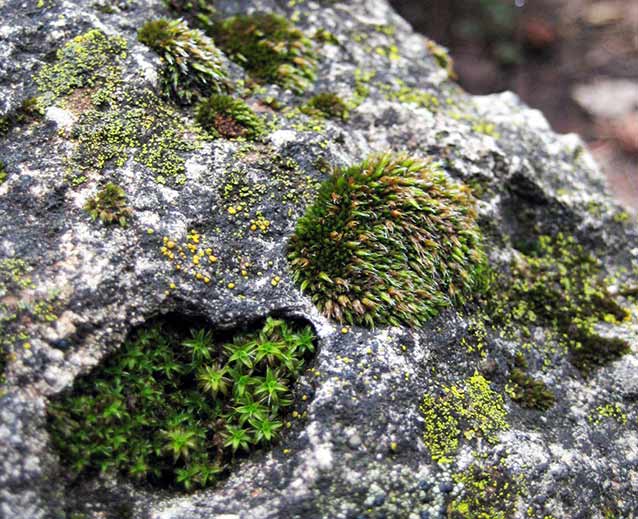
© Theresa Clark
Bryophytes comprise a group of plants that includes the mosses, liverworts and hornworts. They do not flower or produce seeds, but instead reproduce via spores. They do not have a vascular system to pull water and nutrients up from the ground, but absorb water and nutrients through their leafy shoots—the gametophores. They are regarded as transitional between aquatic plants, like algae, and higher land plants, like trees. One of the largest groups of land plants, bryophytes can be found almost anywhere in the world. About 25,000 different species of bryophytes exist. This project summary describes the bryophyte inventory that was conducted in Grand Canyon NP by Northern Arizona University graduate student Theresa Clark. The project was funded by the NPS Inventory & Monitoring Program and managed by the Southern Colorado Plateau Network.
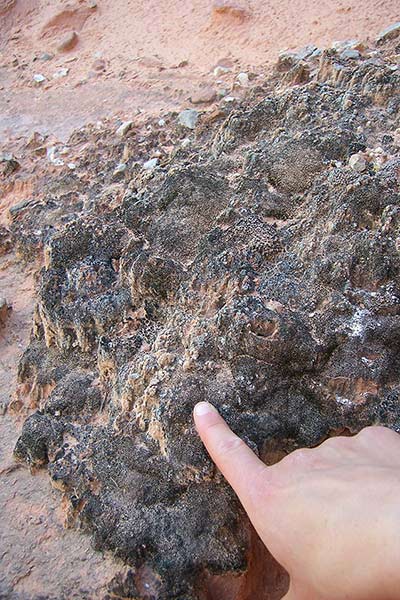
© Theresa Clark
In the American Southwest, bryophytes are small in stature and so low in biomass that they are easily overlooked. However, bryophytes play as critical a role in arid ecosystems as they do in temperate and tropical ones, where they can cover entire surfaces of trees, logs, and rocks. One of the first groups of organisms to colonize lands some 400 million years ago, bryophytes contribute to soil stabilization, seedling establishment, biogeochemical cycling, symbiotic relationships and habitat creation for micro and macroinvertebrates.
In arid ecosystems, the functionality of bryophytes is often augmented by other small and cryptic organisms, namely algae, bacteria, lichens, and cyanobacteria, which co-establish with bryophytes to form biotic soil crust. Collectively the interwoven crust community plays a significant role in aridland ecosystems and can be found colonizing exposed soil in much of the Southwest.
- In sandy soils, the high water-holding capacity of bryophytes and neighboring algal-fungal networks aids in water uptake and retention by soil following rain events.
- This water-holding capacity, combined with the binding properties of soil crust, increases the integrity of soil surfaces and prevents erosion due to wind and water.
- The moist, stable surfaces provided by soil crust facilitate seedling germination.
- Bryophyte communities provide vital habitat to micro and macroinvertebrates, such as nematodes, tardigrades, rotifers, mites, and insects.
In addition, both liverworts and mosses are good indicators of environmental conditions, such as air quality and soil quality.
Bryophytes of Grand Canyon National Park
Bryophytes have not been well studied in Arizona—the most recent data was collected more than 35 years ago. For this project, Clark studied the bryophytes of Grand Canyon NP in order to produce a bryoflora for the park. In a secondary related project she collected bryophyte samples in pinyon-juniper, ponderosa pine and mixed conifer forests to look at, among other things, variations in bryophyte composition and abundance across these three forest types.
Bryoflora for Grand Canyon NP
Methods:
Clark gathered the data for the bryoflora of Grand Canyon NP by compiling and reviewing information on historic collections made prior to 1960 and modern collecting efforts since 1960. Vouchers for these collection were housed at the Grand Canyon Herbarium and at Deaver Herbarium at Northern Arizona University in Flagstaff.
She also conducted field sampling in six regions of the park from March 2007 through April 2010. Those regions were (1) the North Rim; (2) the South Rim; (3) the Inner Canyon (below the North and South Rims to 0.5 km from the Colorado River; (4) the Colorado River (1 km corridor); (5) Lake Mead vicinity (most eastern tail of the park, west of the lake); and (6) Marble Canyon (the Lake Mead and Marble Canyon regions were not well sampled because they were difficult to access). Over the course of 56 field days, Clark collected 1,310 samples along trails in the collection regions.
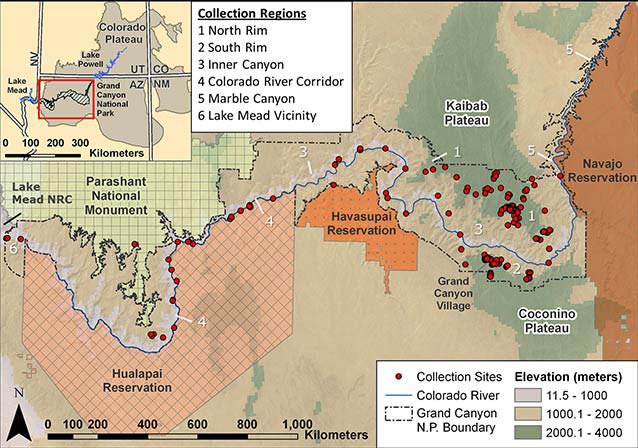
© Theresa Clark
All of the data collected, including the locality data for each specimen, were combined into one database. Clark conducted a floristic analysis and summarized patterns of species distributions across the six regions.
Results
This bryoflora of Grand Canyon NP summarizes the local distribution and habitat-specificity of 155 confirmed bryophyte taxa (153 species, 2 varieties). Records include 28 taxa newly reported for Arizona and 113 new to Grand Canyon NP, some of which mark significant range extensions (e.g. Gyroweisia tenuis and Gymnostomum calcareum). Three taxa remain undescribed or new to science. The results show that the bryoflora of Grand Canyon NP is 1) distributed across the entire elevation gradient in low abundance, but high frequency; 2) dominated by desiccation-tolerant members of the families Pottiaceae, Grimmiaceae, and Bryaceae; 3) includes three species of conservation concern; and 4) is most diverse in the high-elevation mixed conifer forests of the North Rim.
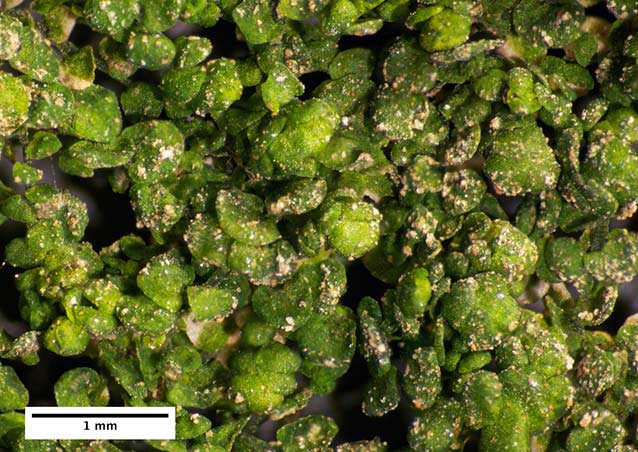
© John Brinda
The Ecology of Rock Bryophytes in Three Forest Types of Grand Canyon NP
In this second related study Clark looked at bryophyte populations in pinyon-juniper, ponderosa pine and mixed conifer forests in Grand Canyon National Park to determine if community species composition differs by forest type and to identify locally dominant and rare species.
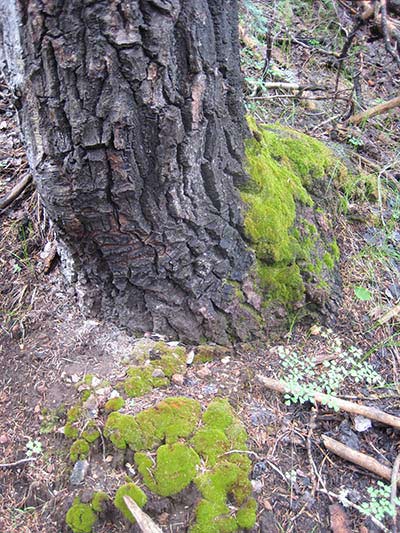
© Theresa Clark
Methods
Clark collected bryophyte samples and environmental data at 104 waypoints along corridor trails distributed across the three targeted forest types. Byrophyte abundance and richness were estimated using 100×1 cm transects randomly oriented on three rocks at each of the 104 waypoints. Analyses were conducted to estimate bryophyte response parameters—species richness, family richness, site-level abundance, total cover, diversity, evenness, and beta diversity. Modeling techniques were used to predict bryophyte compositional differences among forest types, and dominant species distributions.
Results
The samples that Clark collected included 40 rock bryophyte species along trail corridors in the pinyon-juniper, ponderosa pine, and mixed conifer forests of Grand Canyon. Overall, bryophyte abundance was low. Mean richness, abundance, diversity, and evenness were not significantly different among all forest types. Differences were most pronounced between the pinyon-juniper and mixed conifer forests.
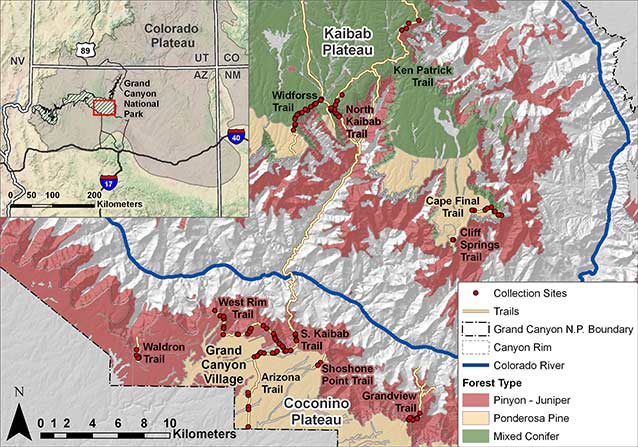
Project Report: Clark, T. A. 2012. Bryophyte floristics and ecology in Grand Canyon National Park. Natural Resource Technical Report NPS/SCPN/NRTR—2012/602. National Park Service, Fort Collins, Colorado.
Prepared by Jean Palumbo, Southern Colorado Plateau Network Inventory and Monitoring Program, 2014.
Last updated: May 5, 2015
